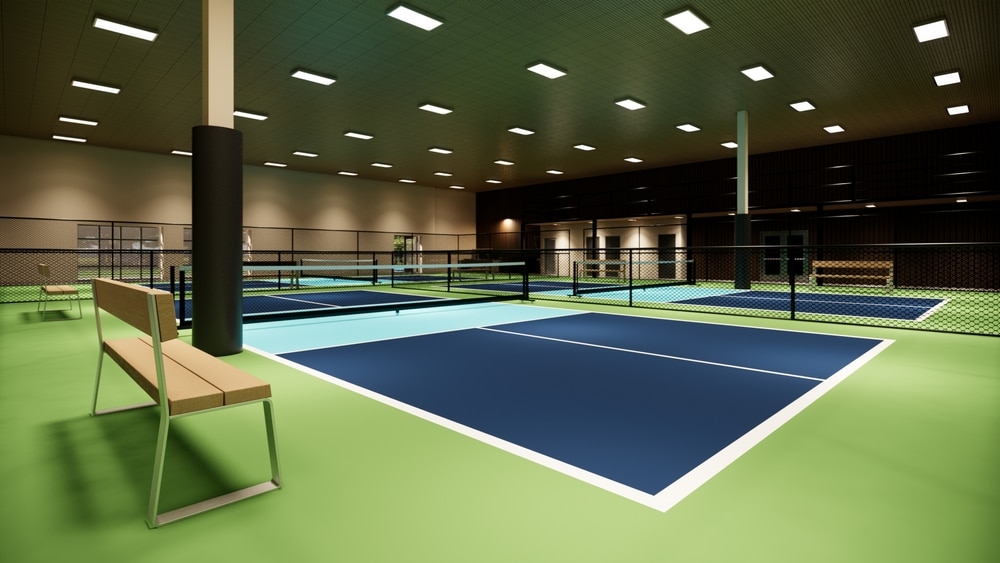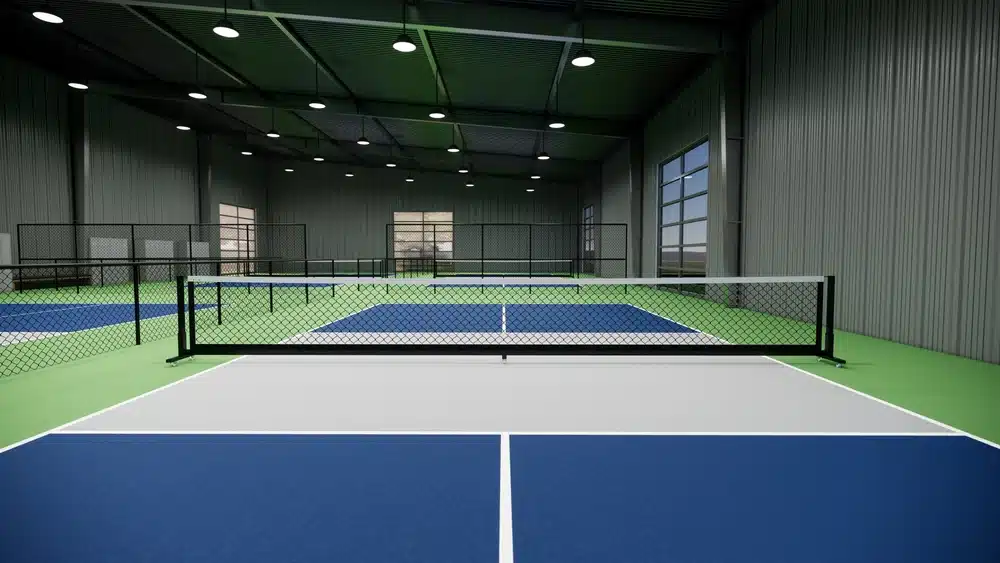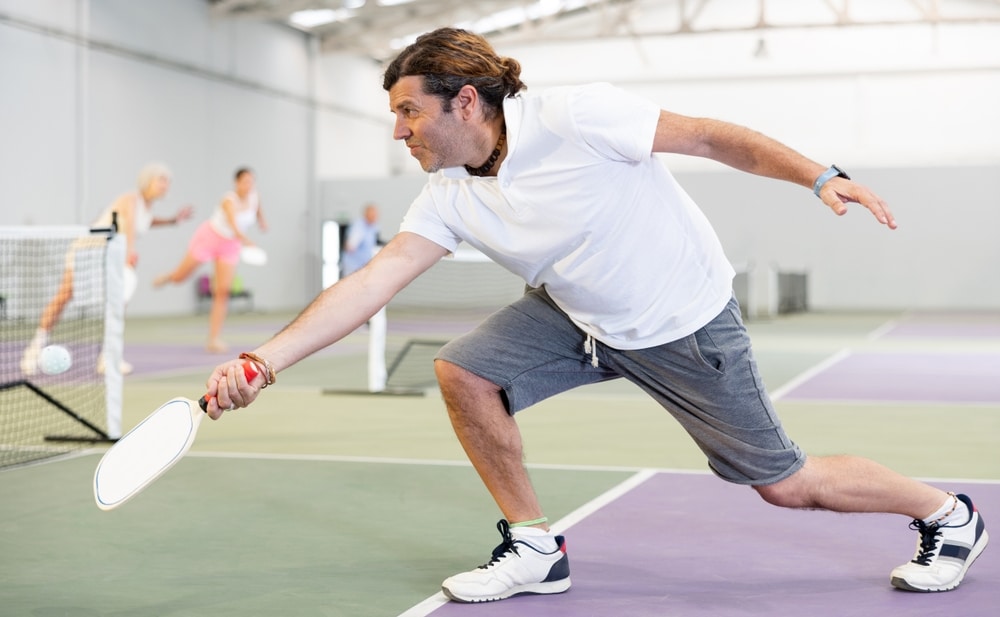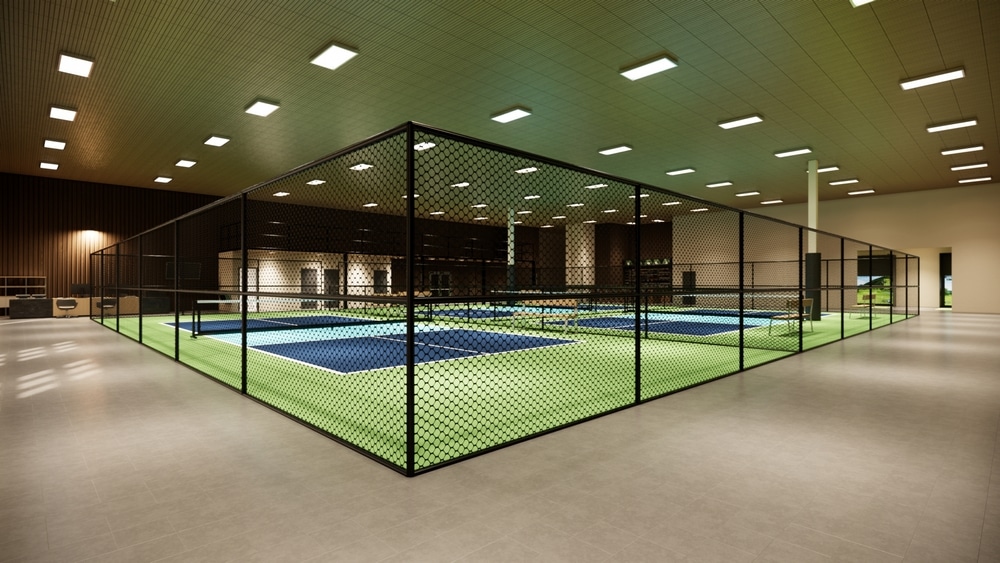Table of Contents
Are you a pickleball enthusiast interested in indoor pickleball courts? You need to keep in mind many factors when playing your indoor pickleball. It’s not just a simple game; one must be professional. Hence, you also need to understand the pickleball court’s size and dimensions. But you don’t have to worry anymore, as we are delving into the world of pickleball court. From the side of the net to the pickleball court surfaces, we will explore everything ahead.
Indoor Pickleball Courts

Pickleball lovers from all walks of life are drawn to indoor courts because they are a center of activity where they may play this thrilling and fast-paced sport. In contrast to outdoor courts, indoor pickleball facilities have proportions designed to fit within the boundaries of leisure centers and private places. These courts, which are usually 20 feet wide by 44 feet long, give players plenty of space to display their abilities while preserving the fast-paced atmosphere of the game.
When building an indoor pickleball court, there are several things to consider, such as the type of surface to be used and following USA Pickleball (USAP) rules. The best grip and durability are ensured by using materials like rubberized surfaces, hardwood floors, or synthetic flooring, and adherence to USAP regulations ensures that every player has an equitable and consistent playing experience. Indoor pickleball courts provide the perfect setting for players to experience the thrill of the game all year long, provided that the rules are followed and appropriate attention to detail is paid.
Why Choose Indoor Pickleball Courts?
Consistent Playing Conditions
Unlike outdoor courts, which are affected by wind, rain, or extreme temperatures, indoor pickleball courts offer a stable environment. This ensures a fair game and allows for better focus on technique.
Superior Court Surface
Indoor courts often feature cushioned or wooden surfaces, which can be gentler on the joints compared to hard outdoor surfaces like asphalt or concrete. Compared to outdoor choices, indoor pickleball court surfaces provide several advantages, including weather protection and upkeep.
Even Lighting
Properly lit indoor courts eliminate shadows and glare, providing better visibility of the ball and improving reaction times.
Extended Play Hours
Most indoor facilities operate year-round, regardless of weather or daylight hours, allowing players to practice whenever it suits their schedule.
Key Features to Look for in an Indoor Pickleball Court

When selecting a venue, consider these important factors:
- Court Surface: A cushioned or wooden surface reduces impact on knees and joints, while a smooth finish enhances ball control.
- Court Size and Layout: Regulation-size courts with adequate spacing between them prevent interference from neighboring games.
- Net Height and Markings: Properly maintained nets and clear boundary lines are essential for competitive play.
- Facility Amenities: Look for venues with locker rooms, seating areas, pro shops, and equipment rentals for added convenience.
- Membership and Booking Options: Some facilities require membership, while others offer drop-in sessions or hourly rentals.
Indoor Pickleball Courts: Standard Sizes
Indoor pickleball courts are measured precisely for uniformity and equitable play.
- They are typically 44 feet long and 20 feet wide, including the required game lines in both dimensions.
This consistent size preserves consistency between various playing locations while giving players plenty of room for intense rallies and tactical moves.
- The net, which is 34 inches tall in the center and 36 inches off the ground on each side, is an essential part of an indoor pickleball court.
This net height promotes optimal gaming by enabling players to perform shots accurately and maintain a manageable degree of difficulty. A crucial feature of an indoor pickleball court’s layout is the kitchen or the 7-foot non-volley zone. This region stretches outward from the net to prevent players from stepping inside when hitting the ball. Following accepted sizes and measurements guarantees uniformity and equity in indoor pickleball matches, giving participants a fitting setting to demonstrate their abilities and fully enjoy the game.
How to Build an Indoor Pickleball Court

A few important factors must be considered when building indoor pickleball courts to ensure the project’s success.
Choosing the Court Sizes and Layout
Before starting construction, it is crucial to choose the number of courts housed in the facility and whether they will be utilized for pickleball or in conjunction with tennis or badminton courts. This choice affects the structure’s overall dimensions and design. Because tennis courts and pickleball courts are not the same size, careful planning is required to accommodate both and make the most use of available space.
Climate and Options for Enclosure
Planning the facility’s enclosure requires a thorough understanding of the local climate for indoor pickleball courts. Depending on the environment, options range from partially covered, open-air constructions to fully enclosed, insulated buildings. Every strategy has benefits, and the decision should consider the intended playing field and seasonal factors.
Choosing Cladding Material
Cladding material greatly influences the comfort and longevity of indoor courts. Insulated metal panels provide durability and thermal efficiency, making them appropriate for difficult climates. Contrarily, fabric cladding diffuses natural light to create a comfortable playing surface. All year round, ClearSpan Structures provides cloth covers that keep temperatures comfortable.
Choosing the Right Court Surface
The next step is to choose the right court surface. Indoor pickleball courts offer greater material versatility than outdoor ones, typically with asphalt or concrete surfaces. Hardwood floors, rubberized surfaces, and even dedicated pickleball court tiles are popular. Selecting the surface that best fits your needs and tastes is crucial because each has unique advantages in traction, durability, and upkeep requirements.
Draw Court Lines
After selecting your surface, the court lines need to be drawn in. Depending on your tastes and budget, you may use tiles, paint, or even tape to do this. A non-volley zone, a centerline, and boundary lines are all features of a typical pickleball court that must be precisely delineated to guarantee fair play.
Illumination
Ample illumination is necessary for play at night, even though natural light may be sufficient during the day. Indirect illumination or energy-efficient LED lighting is a standard option for indoor pickleball courts. By reducing glare, indirect lighting ensures ideal visibility without interfering with gameplay.
Cost Estimation
You must be wondering about the cost of building an indoor pickleball court. One way to estimate the cost is to count the price of building materials, labor, and other amenities like surface treatments and lighting. ClearSpan can offer customized solutions that satisfy financial constraints without sacrificing quality.
Accessibility and Amenities
Accessible elements and amenities, including seating sections, restrooms, and equipment storage, should be considered to improve the overall player experience. Operators may build indoor pickleball courts facilities that provide players of all skill levels with a pleasurable and sustainable playing experience by carefully considering these factors during the planning and design stages.
Pickleball Court Dimensions Indoor

Pickleball fans are increasingly drawn to indoor facilities because it’s a fast-paced, dynamic activity. Certain rules must be followed when building the court’s dimensions to guarantee a consistent and fun playing experience. These measurements affect player safety and game flow and dictate the court’s structure.
Let’s start by discussing the many elements of an indoor pickleball court’s dimensions.
Sidelines
The sidelines are 44 feet long and run the entire floor. They create a distinct boundary for inbounds, play pickleball, and define the playing area’s outer bounds area.
Baselines
Twenty feet in length and placed at either end of the court, the baselines parallel the net and delineate the area from which players serve and return shots.
Centerline
For indoor pickleball courts, the centerline separates the court into two halves and runs down the middle from baseline to baseline. It directs players throughout the games and divides the service sections.
Service Areas
The centerline forms two 15-foot-long service areas on either side of the net. Players must stand in these specific areas to serve the ball into play.
Non-volley zones
These 7-foot-wide areas are parallel to the baselines and on opposite sides of the net. Players are encouraged to use shot selection and strategic placement by not volleying the ball when standing in these spots.
Net Height
Pickleball nets are 36 inches high at the sides and 34 inches high in middle, occupying the whole width of the court. These little tapering guarantees uniformity and fair play all around the court.
Top Indoor Pickleball Courts in the U.S.
1. Chicken N Pickle (Multiple Locations)
- A unique pickleball venue combined with a restaurant and entertainment space.
- High-quality indoor courts with professional lighting.
- Ideal for social play and league competitions.
2. Life Time Fitness (Nationwide)
- Premium health club chain offering dedicated pickleball courts.
- Well-maintained facilities with coaching and training sessions.
- Excellent for beginners and advanced players.
3. Pickleball Kingdom (Arizona)
- The largest indoor pickleball facility in the country.
- Climate-controlled courts with professional-grade surfaces.
- Offers memberships, lessons, and tournaments.
4. The Pickle Lodge (Ohio)
- A state-of-the-art pickleball club with dedicated courts.
- Hosts open play sessions, private lessons, and leagues.
- Perfect for those looking to improve their skills.
5. Smash Pickleball Club (Seattle, WA)
- One of the premier indoor facilities on the West Coast.
- Designed for both recreational and professional-level play.
- Focuses on community building through pickleball.
Final Thoughts
In conclusion, there is a growing need for indoor pickleball courts in both private homes and specialized establishments due to the sport’s growing appeal. If enthusiasts want to build their indoor pickleball courts, they must be aware of the measurements and requirements of these facilities, including court size, surface materials, and net location. The cost to construct an indoor pickleball court varies based on location, materials, and facilities, whether it is done for leisure or as part of a business project. Hence, building a practical and entertaining indoor pickleball facility with careful planning and attention to detail can amuse players of all skill levels for many hours, promoting the growth and accessibility of the sport both indoors and outside.




